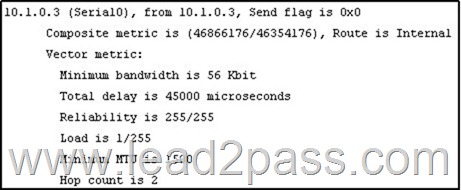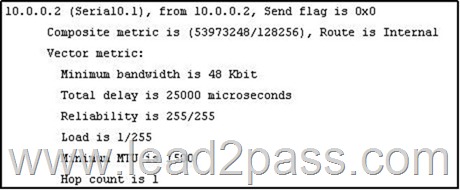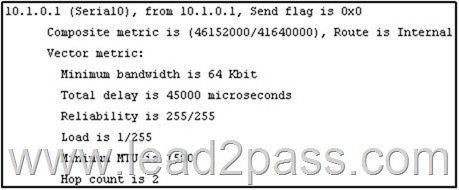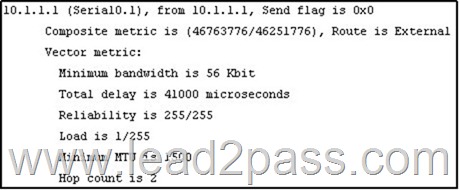2016 September Cisco Official New Released 200-105 Dumps in Lead2pass.com!
100% Free Download! 100% Pass Guaranteed!
Lead2pass dumps for 200-105 exam are written to the highest standards of technical accuracy, provided by our certified subject matter experts and published authors for development. We guarantee the best quality and accuracy of our products. We hope you pass the exams successfully with our practice test. With our Cisco 200-105 dumps, you will pass your exam easily at the first attempt. You can also enjoy 365 days free update for your product.
Following questions and answers are all new published by Cisco Official Exam Center: http://www.lead2pass.com/200-105.html
QUESTION 51
You enter the show ipv6 route command on an OSPF device and the device displays a route. Which conclusion can you draw about the environment?
A. OSPF is distributing IPv6 routes to BGP.
B. The router is designated as an ABR.
C. The router is designated as totally stubby.
D. OSPFv3 is in use.
Answer: A
QUESTION 52
Refer to the exhibit. How will the router handle a packet destined for 192.0.2.156? 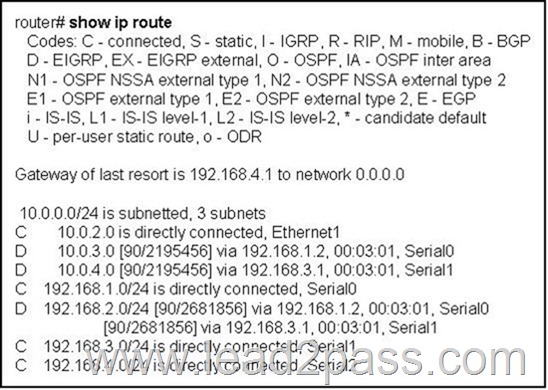
A. The router will drop the packet.
B. The router will return the packet to its source.
C. The router will forward the packet via Serial2.
D. The router will forward the packet via either Serial0 or Serial1.
Answer: C
Explanation:
Router has pointed default router to 192.168.4.1 and this subnet is connected via serial 2 interface. Router does not have router for the 192.0.2.156. so it will use the default gateway 192.168.4.1. A default route identifies the gateway IP address to which the router sends all IP packets for which it does not have a learned or static route.
QUESTION 53
Refer to the exhibit.
Which two statements are true about interVLAN routing in the topology that is shown in the exhibit? (Choose two.) 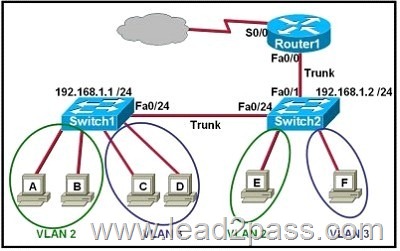
A. Host E and host F use the same IP gateway address.
B. Router1 and Switch2 should be connected via a crossover cable.
C. Router1 will not play a role in communications between host A and host D.
D. The FastEthernet 0/0 interface on Router1 must be configured with subinterfaces.
E. Router1 needs more LAN interfaces to accommodate the VLANs that are shown in the exhibit.
F. The FastEthernet 0/0 interface on Router1 and the FastEthernet 0/1 interface on Switch2 trunk ports
must be configured using the same encapsulation type.
Answer: DF
Explanation:
http://www.cisco.com/en/US/tech/tk389/tk815/technologies_configuration_example09186a00800949fd.shtml
QUESTION 54
What is the advantage of using a multipoint interface instead of point-to-point subinterfaces when configuring a Frame Relay hub in a hub-and-spoke topology?
A. It avoids split-horizon issues with distance vector routing protocols.
B. IP addresses can be conserved if VLSM is not being used for subnetting.
C. A multipoint interface offers greater security compared to point-to-point subinterface configurations.
D. The multiple IP network addresses required for a multipoint interface provide greater addressing flexibility
over point-to-point configurations.
Answer: B
Explanation:
you do not have to assign a separate subnet per sub-interface .if you’re using a Class A network (10.x.x.x/8), you blow the whole network on a few connections (if you used VLSM, you could use a better mask, limit the addresses used). if you used 10.0.0.0/8, you would not be assigning the entire /8 to a single network. You would select a subnet mask for the network and then, you would have to use that mask with all subnets of the network. So if you chose a /24 mask, that would mean that you would have to use a /24 mask for even point-to-point links.
QUESTION 55
Which two statistics appear in show frame-relay map output? (Choose two.)
A. the number of BECN packets that are received by the router
B. the value of the local DLCI
C. the number of FECN packets that are received by the router
D. the status of the PVC that is configured on the router
E. the IP address of the local router
Answer: BD
Explanation:
Frame Relay Commands (map-class frame-relay through threshold ecn)
http://www.cisco.com/en/US/docs/ios/12_2/wan/command/wrffr4.html#wp102934
Examples
The following is sample output from the show frame-relay map command:
Router#show frame-relay map Serial 1 (administratively down): ip 10.108.177.177 dlci 177 (0xB1,0x2C10), static, broadcast,
CISCO
TCP/IP Header Compression (inherited), passive (inherited)
QUESTION 56
Which protocol is an open standard protocol framework that is commonly used in VPNs, to provide secure end-to-end communications?
A. RSA
B. L2TP
C. IPsec
D. PPTP
Answer: C
Explanation:
Internet Protocol Security (IPsec) is a technology protocol suite for securing Internet Protocol (IP) communications by authenticating and/or encrypting each IP packet of a communication session. IPsec also includes protocols for establishing mutual authentication between agents at the beginning of the session and negotiation of cryptographic keys to be used during the session.
QUESTION 57
At which layer of the OSI model does PPP perform?
A. Layer 2
B. Layer 3
C. Layer 4
D. Layer 5
Answer: A
Explanation:
Point-to-Point Protocol (PPP) is a data link protocol commonly used in establishing a direct connection between two networking nodes. It can provide connection authentication, transmission encryption (using ECP, RFC 1968), and compression.
QUESTION 58
The command show frame-relay map gives the following output:
Serial 0 (up): ip 192.168.151.4 dlci 122, dynamic, broadcast, status defined, active
Which statements represent what is shown?(Choose three.)
A. 192.168.151.4 represents the IP address of the remote router
B. 192.168.151.4 represents the IP address of the local serial interface
C. DLCI 122 represents the interface of the remote serial interface
D. DLCI 122 represents the local number used to connect to the remote address
E. broadcast indicates that a dynamic routing protocol such as RIP v1 can send packets across this PVC
F. active indicates that the ARP process is working
Answer: ADE
Explanation:
http://www.cisco.com/en/US/docs/ios/12_2/wan/command/reference/wrffr4.html#wp1029343
QUESTION 59
What can be done to Frame Relay to resolve split-horizon issues?(Choose two.)
A. Disable Inverse ARP.
B. Create a full-mesh topology.
C. Develop multipoint subinterfaces.
D. Configure point-to-point subinterfaces.
E. Remove the broadcast keyword from the frame-relay map command.
Answer: BD
Explanation:
IP split horizon checking is disabled by default for Frame Relay encapsulation to allow routing updates to go in and out of the same interface. An exception is the Enhanced Interior Gateway Routing Protocol (EIGRP) for which split horizon must be explicitly disabled. Certain protocols such as AppleTalk, transparent bridging, and Internetwork Packet Exchange (IPX) cannot be supported on partially meshed networks because they require split horizon to be enabled (a packet received on an interface cannot be transmitted over the same interface, even if the packet is received and transmitted on different virtual circuits). Configuring Frame Relay subinterfaces ensures that a single physical interface is treated as multiple virtual interfaces. This capability allows you to overcome split horizon rules so packets received on one virtual interface can be forwarded to another virtual interface, even if they are configured on the same physical interface.
QUESTION 60
What are three reasons that an organization with multiple branch offices and roaming users might implement a Cisco VPN solution instead of point-to-point WAN links? (Choose three.)
A. reduced cost
B. better throughput
C. broadband incompatibility
D. increased security
E. scalability
F. reduced latency
Answer: ADE
Explanation:
http://www.cisco.com/en/US/products/ps5743/Products_Sub_Category_Home.html#~Benefits
Enhance Productivity and Cut Costs
Cisco VPN solutions provide exceptional security through encryption and authentication technologies that protect data in transit from unauthorized access and attacks. A Cisco VPN helps you:
Use highly secure communications, with access rights tailored to individual users Quickly add new sites or users, without significantly expanding your existing infrastructure Improve productivity by extending corporate networks, applications, and collaboration tools Reduce communications costs while increasing flexibility
QUESTION 61
Which command is used to enable CHAP authentication, with PAP as the fallback method, on a serial interface?
A. Router(config-if)# ppp authentication chap fallback ppp
B. Router(config-if)# ppp authentication chap pap
C. Router(config-if)# authentication ppp chap fallback ppp
D. Router(config-if)# authentication ppp chap pap
Answer: B
Explanation:
http://www.cisco.com/en/US/docs/ios/12_2/security/configuration/guide/scfathen.html
QUESTION 62
What is the result of issuing the frame-relay map ip 192.168.1.2 202 broadcast command?
A. defines the destination IP address that is used in all broadcast packets on DCLI 202
B. defines the source IP address that is used in all broadcast packets on DCLI 202
C. defines the DLCI on which packets from the 192.168.1.2 IP address are received
D. defines the DLCI that is used for all packets that are sent to the 192.168.1.2 IP address
Answer: D
Explanation:
frame-relay map ip 192.168.1.2 202 command statically defines a mapping between a network layer address and a DLCI. The broadcast option allows multicast and broadcast packets to flow across the link.
The command frame-relay map ip 192.168.1.2 202 broadcast means to mapping the distal IP 192.168.1.2 202 to the local DLCI . When the “broadcast” keyword is included, it turns Frame Relay network as a broadcast network, which can forward broadcasts. http://www.cisco.com/en/US/docs/ios/wan/command/reference/wan_f2.html#wp1012264
QUESTION 63
Which Layer 2 protocol encapsulation type supports synchronous and asynchronous circuits and has built-in security mechanisms?
A. HDLC
B. PPP
C. X.25
D. Frame Relay
Answer: B
Explanation:
High-Level Data Link Control (HDLC) – HDLC is the default encapsulation type on point-to-point, dedicated links, and circuit-switched connections. It is used typically when communicating between two Cisco devices. It is a bit-oriented synchronous data link layer protocol.
Point-to-Point Protocol (PPP) – Provides router-to-router and host-to network connections over synchronous and asynchronous circuits. PPP was designed to work with several network layer protocols, such as IP, and IPX. PPP also has built in security mechanisms such as PAP and CHAP X.25/Link Access Procedure, Balanced (LAPB) – ITU-T standard that defines how connections between DTE and DCE are maintained for remote terminal access and computer communications in public data networks. X.25 specifies LAPB, a data line layer protocol.
X.25 is a predecessor to Frame Relay.
Frame Relay – Industry standard, switched data link layer protocol that handles multiple virtual circuits. It is a next-generation to X.25 that is streamlined to eliminate some of the time-consuming processes (such as error correction and flow control) that were employed in X.25.
QUESTION 64
Which encapsulation type is a Frame Relay encapsulation type that is supported by Cisco routers?
A. IETF
B. ANSI Annex D
C. Q9333-A Annex A
D. HDLC
Answer: A
Explanation:
Cisco supports two Frame Relay encapsulation types: the Cisco encapsulation and the IETF Frame Relay encapsulation, which is in conformance with RFC 1490 and RFC 2427. The former is often used to connect two Cisco routers while the latter is used to connect a Cisco router to a non-Cisco router. You can test with your Cisco router when typing the command
Router(config-if)#encapsulation frame-relay ? on a WAN link.
Note: Three LMI options are supported by Cisco routers are ansi, Cisco, and Q933a. They represent the ANSI Annex D, Cisco, and ITU Q933-A (Annex A) LMI types, respectively.
HDLC is a WAN protocol same as Frame-Relay and PPP so it is not a Frame Relay encapsulation type.
QUESTION 65
The internetwork infrastructure of company XYZ consists of a single OSPF area as shown in the graphic. There is concern that a lack of router resources is impeding internetwork performance. As part of examining the router resources, the OSPF DRs need to be known. All the router OSPF priorities are at the default and the router IDs are shown with each router. Which routers are likely to have been elected as DR? (Choose two.)
A. Corp-1
B. Corp-2
C. Corp-3
D. Corp-4
E. Branch-1
F. Branch-2
Answer: DF
Explanation:
There are 2 segments on the topology above which are separated by Corp-3 router.
Each segment will have a DR so we have 2 DRs.
To select which router will become DR they will compare their router-IDs. The router with highest (best) router-ID will become DR. The router-ID is chosen in the order below:
The highest IP address assigned to a loopback (logical) interface. If a loopback interface is not defined, the highest IP address of all active router’s physical interfaces will be chosen.
In this question, the IP addresses of loopback interfaces are not mentioned so we will consider IP addresses of all active router’s physical interfaces. Router Corp-4 (10.1.40.40) & Branch-2 (10.2.20.20) have highest “active” IP addresses so they will become DRs.
QUESTION 66
A network administrator needs to configure a serial link between the main office and a remote location. The router at the remote office is a non-Cisco router. How should the network administrator configure the serial interface of the main office router to make the connection?
A. Main(config)# interface serial 0/0
Main(config-if)# ip address 172.16.1.1 255.255.255.252
Main(config-if)# no shut
B. Main(config)# interface serial 0/0
Main(config-if)# ip address 172.16.1.1 255.255.255.252
Main(config-if)# encapsulation ppp
Main(config-if)# no shut
C. Main(config)# interface serial 0/0
Main(config-if)# ip address 172.16.1.1 255.255.255.252
Main(config-if)# encapsulation frame-relay
Main(config-if)# authentication chap
Main(config-if)# no shut
D. Main(config)# interface serial 0/0
Main(config-if)#ip address 172.16.1.1 255.255.255.252
Main(config-if)#encapsulation ietf
Main(config-if)# no shut
Answer: B
Explanation:
Cisco High-Level Data Link Controller (HDLC) is the Cisco proprietary protocol for sending data over synchronous serial links using HDLC. So HDLC runs only in Cisco router. PPP is not proprietary protocol it’s a open source every cisco router and non-cisco router understand the PPP protocol.So we need to configure the PPP protocol if connection is between cisco and non-cisco router.
QUESTION 67
Which PPP subprotocol negotiates authentication options?
A. NCP
B. ISDN
C. SLIP
D. LCP
E. DLCI
Answer: D
Explanation:
A protocol that establishes, configures, and tests data link connections used by the PPP Link Control Protocol offers PPP encapsulation different options, including the following:
Authentication – options includes PAP and CHAP
Compression – Data compression increases the throughput on a network link, by reducing the amount of data that must be transmitted. Error Detection -Quality and Magic numbers are used by PPP to ensure a reliable, loop-free data link.
Multilink – Supported in IOS 11.1 and later, multilink is supported on PPP links between Cisco routers. This splits the load for PPP over two or more parallel circuits and is called a bundle.
QUESTION 68
Refer to the exhibit.
Assuming that the entire network topology is shown, what is the operational status of the interfaces of R2 as indicated by the command output shown? 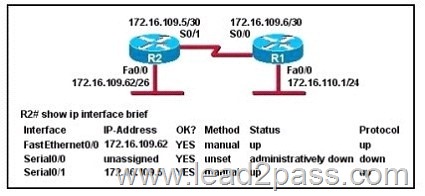
A. One interface has a problem.
B. Two interfaces have problems.
C. The interfaces are functioning correctly.
D. The operational status of the interfaces cannot be determined from the output shown.
Answer: C
Explanation:
R2 has setup with two interface s0/1 and fa0/0 and both are interfaces configured with IP address and up. “show ip interface brief” showing the status of R2 interfaces.
QUESTION 69
Which two statements describe the process identifier that is used in the command to configure OSPF on a router? (Choose two.)
Router(config)# router ospf 1
A. All OSPF routers in an area must have the same process ID.
B. Only one process number can be used on the same router.
C. Different process identifiers can be used to run multiple OSPF processes
D. The process number can be any number from 1 to 65,535.
E. Hello packets are sent to each neighbor to determine the processor identifier.
Answer: CD
Explanation:
we all know that The areas can be any number from 0 to 4.2 billion and 1 to 65,535 for the Process ID.
The process ID is the ID of the OSPF process to which the interface belongs. The process ID is local to the router, and two OSPF neighboring routers can have different OSPF process IDs. (This is not true of Enhanced Interior Gateway Routing Protocol [EIGRP], in which the routers need to be in the same autonomous system). Cisco IOS Software can run multiple OSPF processes on the same router, and the process ID merely distinguishes one process from the another. The process ID should be a positive integer.
QUESTION 70
Refer to the exhibit.
Given the output from the show ip eigrp topology command, which router is the feasible successor? 
Answer: B
Explanation:
http://networklessons.com/eigrp/eigrp-neighbor-and-topology-table-explained/
To be the feasible successor, the Advertised Distance (AD) of that route must be less than the Feasible Distance (FD) of the successor. From the output of the “show ip eigrp topology 10.0.0.5 255.255.255.255 we learn that the FD of the successor is 41152000.
Now we will mention about the answers, in the “Composite metric is (…/…)” statement the first parameter is the FD while the second parameter is the AD of that route. So we need to find out which route has the second parameter (AD) less than 41152000 -> only answer B satisfies this requirement with an AD of 128256.
We offer standard exam questions of Cisco 200-105 dumps. The standard exams are important if you have never taken a real exam. The accuracy of the Q&As are fully guaranteed and the number is enough to impact you passing the exam.
200-105 new questions on Google Drive: https://drive.google.com/open?id=0B3Syig5i8gpDY2V1UExCV21ZUHM
2016 Cisco 200-105 exam dumps (All 346 Q&As) from Lead2pass:
http://www.lead2pass.com/200-105.html [100% Exam Pass Guaranteed]
